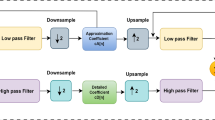Abstract
In this paper, we present an automatic artifact removal method by combining independent component analysis (ICA) and wavelet denoising to remove artifacts from attention deficit hyperactivity disorder (ADHD) electroencephalograms (EEGs). First, the ICA algorithm is used to analyze EEG signals to get the independent components (ICs); then, the wavelet method is applied to the demixed ICs as an intermediate step; finally, the EEG data are reconstructed from the new ICs (that are obtained in the intermediate step) by using the inverse ICA. The experimental results show that the automatic artifact removal method can not only remove eye artifacts, muscle artifacts and some unknown physiological artifacts sources, but also efficiently keep the weak neural activities from strong background artifacts. The results can establish a basis for ADHD clinical diagnose study.








Similar content being viewed by others
Explore related subjects
Discover the latest articles and news from researchers in related subjects, suggested using machine learning.References
Spronk M, Jonkman LM, Kemner C. Response inhibition and attention processing in 5- to 7-year-old children with and without symptoms of ADHD: an ERP study. Clin Neurophysiol. 2008;119:2738–52.
Alexander DM, Hermens DF, Keage HA, Clark CR, Williams LM, Kohn MR, Kohn MR, Clarke SD, Lamb C, Gordon E. Event-related wave activity in the EEG provides new marker of ADHD. Clin Neurophysiol. 2008;119:163–79.
Madureira DQM, Carvalho LAV, Cheniaux E. Attentional focus modulated by mesothalamic dopamine: consequences in Parkinson’s disease and attention deficit hyperactivity disorder. Cogn Comput. 2010;2:31–49.
Wiersema R, Van der Meere J, Roeyers H, Van Coster R, Baeyens D. Event rate and event-related potentials in ADHD. J Child Psychol Psychiatry. 2006;47:560–7.
Sikstrom S, Soderlund G. Stimulus-dependent dopamine release in attention-deficit/hyperactivity disorder. Psychol Rev. 2007;114:1047–75.
Jung TP, Makeig S, Humphries C, Lee TW, McKeown MJ, Iragui V, Sejnowski TJ. Removing electroencephalographic artifacts by blind source separation. Psychophysiology. 2000;37(2):163–78.
Delorme A, Sejnowski T, Makeig S. Enhanced detection of artifacts in EEG data using higher-order statistics and independent component analysis. NeuroImage. 2007;34:1443–9.
Zhu Y, Shayan A, Zhang W, Chen TL, Jung TP, Duann JR, Makeig S, Cheng CK. Analyzing high-density ECG signals using ICA. IEEE Trans Biomed Eng. 2008;55:2528–37.
Zou L, Duan S, Ma Zh, Yang Ch. Single-trial event related potentials extraction by using independent component analysis. In: The 2nd international conference on biomedical engineering and informatics. 2009; pp. 721–5.
Inuso G, La Foresta F, Mammone N, Morabito FC. Wavelet-ICA methodology for efficient artifact removal from Electroencephalographic recordings. In: Proceedings of IEEE IJCNN. 2007; pp. 1524–9.
Demiralp T, Ademoglu A, Istefanopulos Y, Basar-Eroglu C, Basar E. Wavelet analysis of oddball P300. Int J Psychophysiol. 2001;39:221–7.
Zou L, Tao C, Zhang X, Zhou RL. Estimation of Event Related Potentials Using Wavelet Denoising Based Method. In: 7th International symposium on neural networks. 2010; vol. 4128, pp. 400–7.
Zou L, Zhou R, Hu S, Zhang J, Li Y. Single trial evoked potentials study during an emotional processing based on wavelet transform. In: 5th International symposium on neural networks. 2008; vol. 5263, pp. 1–10.
Akhtar MT, Mitsuhashi W, James CJ. Employing spatially constrained ICA and wavelet denoising, for automatic removal of artifacts from multichannel EEG data. Signal Process. 2012;92:401–16.
Ting KH, Fung PCW, Chang CQ, Chan FHY. Automatic correction of artifact from single-trial event-related potentials by blind source separation using second order statistics only. Med Eng Phys. 2006;28:781–94.
Belouchrani A, Abed-Meraim K, Cardoso J-F, Moulines E. A blind source separation technique based on second-order statistics. IEEE Trans Signal Process. 1997;45:434–44.
Cardoso J-F. High-order contrasts for independent component analysis. Neural Comput. 1999;11:157–92.
Ruijiang L, Principe JC. Blinking artifact removal in cognitive EEG data using ICA. In: Proceedings of the 28th IEEE EMBS annual international conference, New York City, USA, Aug 30–Sept 3, 2006; pp. 5273–6.
Lee T-W. Independent component analysis—theory and applications. Dordrecht: Kluwer Academic Publishers; 1998.
Jung T-P, Makeig S, Humphries C, Lee T-W, McKeown MJ, Iragui V, Sejnowski TJ. Removing electroencephalographic artifacts by blind source separation. Psychophysiology. 2000;37:163–78.
Donoho DL, Johnston IM. Adapting to unknown smoothness via wavelet shrinkage. J Am Stat Assoc. 1995;90:1200–24.
Zou L, Zhang Y, Laurence TY, Zhou R. Single trial evoked potentials study by combining wavelet denoising and principal component analysis method. J Clin Neurophysiol. 2010;27:17–24.
Chang SG, Yu B, Vettreli M. Adaptive wavelet thresholding for image denoising and compression. IEEE Trans Image Process. 2000;9:1532–46.
Polikar R, Topalis A, Green D, Kounios J, Clark CM. Comparative multiresolution wavelet analysis of ERP spectral bands using an ensemble of classifiers approach for early diagnosis of Alzheimer’s disease. Comput Biol Med. 2007;37:542–56.
Acknowledgments
This work has been partially supported by the open project of the State Key Laboratory of Robotics and System at Harbin Institute of Technology (SKLRS-2010-2D-09, SKLRS-2010-MS-10), National Natural Science Foundation of China (61201096), the Natural Science Fund for colleges and universities in Jiangsu Province (10KJB510003), the Natural Science Fund in Changzhou City (CJ20110023) and Changzhou High-tech Research Key Laboratory Project (CM20123006). Thanks Dr. Suhong Wang in the First Hospital of Changzhou City for helpful discussion.
Author information
Authors and Affiliations
Corresponding author
Rights and permissions
About this article
Cite this article
Zou, L., Xu, S., Ma, Z. et al. Automatic Removal of Artifacts from Attention Deficit Hyperactivity Disorder Electroencephalograms Based on Independent Component Analysis. Cogn Comput 5, 225–233 (2013). https://doi.org/10.1007/s12559-012-9199-3
Received:
Accepted:
Published:
Issue Date:
DOI: https://doi.org/10.1007/s12559-012-9199-3




